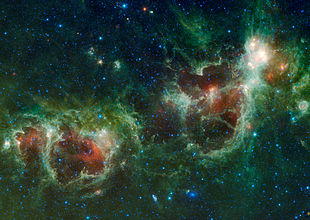Soul mist
| Emission nebula | |
|---|---|
| Soul mist
|
|

|
|
| The soul nebula on the left in infrared (on the right the heart nebula ) | |
| AladinLite | |
| Constellation | Cassiopeia |
|
Position equinox : J2000.0 , epoch : J2000.0 |
|
| Right ascension | 02 h 51 m 10.6 s |
| declination | + 60 ° 24 ′ 09 ″ |
| Appearance
|
|
| Apparent brightness (visual) | 6.5 mag |
| Angular expansion | 150.0 '× 75.0' |
| Ionizing source | |
| designation | W5 |
| Type | radio |
| Physical data
|
|
| distance | 7,500 ly (2,300 pc ) |
| Absolute brightness | 6.5 mag |
|
history
|
|
| discovery | Edward Barnard |
| Catalog names | |
| IC 1848 • Sharpless 2-199, LBN 667 | |
The Soul Nebula (also Sharpless 2-199 or LBN 667 ) is an emission nebula in the constellation of Cassiopeia .
construction
Several small open star clusters are embedded in this nebula : Cr 34 , Cr 632 and Cr 634 in the head and IC 1848 in the body. The object is also commonly known as the latter star cluster IC 1848 .
The small emission nebula IC 1871 can be found on the top left at the head of the soul nebula, other small emission nebulae such as IC 669 and IC 670 are slightly below.
The complex to the east is its neighbor IC 1805, the so-called Heart Nebula . Both are often referred to together as the nebula of the heart and soul .
Between the Heart Nebula and the Soul Nebula, there is the giant elliptical Maffei 1 galaxy on the one hand, and the Maffei 2 spiral galaxy on the other .
Star formation
The W5 is a radio source in the mist that occupies an apparent diameter in the sky of 4 full-moons and in distance of about 7500 light-years of our solar system in the Perseus-arm of the Milky Way is in the constellation Cassiopeia. As in other star formation regions , such as the Orion Nebula or the Carina Nebula , there are also huge cavities in the W5, created by radiation and stellar winds from the largest stars in this region.
According to the theory of triggered star formation, the gas at the edge of these cavities is compressed, causing a chain of successive formation of new stars in the nebula. The images from the Spitzer Space Telescope provide the best confirmation of the theory yet. The astrophysicists who examined these images were able to show that the further the shock front moves away from the center, new young stars keep appearing there; older stars are accordingly closer to the center, and younger ones further out.
photos
Generations of stars can be made out on this infrared image from NASA's Spitzer Space Telescope .
The Heart and Soul Nebulae, recorded by the WISE telescope in infrared.
additional
- List of IC objects
- Infrared astronomy
- Radio astronomy
- Spitzer space telescope
- Herschel space telescope
Web links
- Spitzer Space Telescope
- Triggered Star Formation
- atlasoftheuniverse.com
- Heart and Soul Nebula - Astronomy Picture of the Day of September 14, 2008.
- The Heart and Soul Nebulas - Astronomy Picture of the Day from August 10, 2005 (English).
- The Heart and Soul Nebulas - Astronomy Picture of the Day of October 22, 2003.
- IC 1848: The Soul Nebula - Astronomy Picture of the Day of February 28, 2016 (English).
- Spektrum.de : Amateur recordings [1] [2]
Individual evidence
- ↑ NASA / IPAC EXTRAGALACTIC DATABASE
- ^ SEDS : IC 1848
- ↑ Soul Nebula - Westerhout 5 (IC 1848) | Constellation Guide. Retrieved August 31, 2019 (American English).
- ↑ Seligman
- ^ Koenig, Xavier P. & Lori E. Allen (Harvard-Smithsonian CfA): Spitzer Reveals Stellar 'Family Tree' . NASA / JPL-Caltech. August 22, 2008. Retrieved October 19, 2013.



